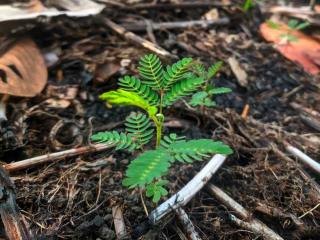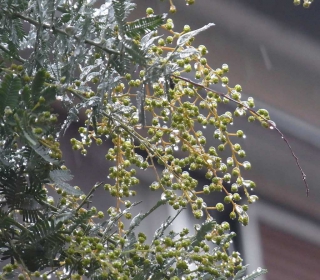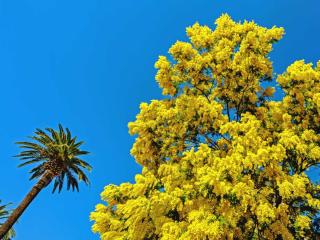

Mimosa, in winter, bears exceptional fragrant, bright gold yellow flowers.
Key facts about mimosa
Name – Acacia dealbata
Family – Mimosaceae
Type – tree
Height – 13 to 32 feet (4 to 10 meters)
Exposure – full sun
Soil: well drained, sandy – Foliage: evergreen – Flowering: winter → spring
Proper planting of the winter mimosa tree, its pruning and the care you’ll give it will help you have a magnificent mimosa tree, whether in pots or in the garden.
Mimosa is planted preferably in spring or in fall in a sunny spot and, ideally, sheltered from wind.

Indeed, mimosa tree particularly loves sun-endowed emplacements that are protected from drafts, and especially well-drained soil.
In regions with harsh winters, your best option is to plant your mimosa tree in large pots so that you may bring them indoors over winter.
Mimosa is a shrub that will grow very well in a pot or large garden box, even though proper growing conditions must be provided.
 It’s a pleasure to place this pot near a window you open in winter to ventilate. The scent will spread through your home!
It’s a pleasure to place this pot near a window you open in winter to ventilate. The scent will spread through your home!Note: Have the best of both worlds! A full-blown tree outside, and a vase with cut branches in the house! Indeed, mimosa buds will still bloom as cut flowers.

When growing directly in the ground and if the weather freezes deeply in your area, protect your tree by implementing our advice on protecting plants against the cold.
If you transfer a potted mimosa to the ground, remember to winterize it for at least three years.
This is especially important if you’ve previously been bringing it indoors for protection.
These first three “outdoor winters” will gradually harden the tree until it can cope against freezing on its own.

Otherwise, mimosa is so vigorous that some people call it an invasive plant. But stand assured: regular care and pruning will restrain its rapid growth.
This tree normally doesn’t need any pruning at all, unless you want to start shaping it somewhat. Important to know is that you should only prune after the blooming is over.

Watering a mimosa tree planted in the ground
Watering potted mimosa
Mimosa is known thanks to florists who sell it in January, when flowers are still in the bud. It already is fragrant enough to spread its scent throughout an entire house!
Its foliage is evergreen and its blooming has a fresh, appealing smell.

Winter’s deepest and darkest months is when this tree drapes itself in full color and releases its delicious spring-like fragrance throughout the neighborhood.
You can also take advantage of all this tree’s gifts on your terrace, balcony or deck if you plant it in a large garden box. Simply water it as soon as the soil turns dry.
Note that there is a certain confusion in terms: the tree that is commonly called Mimosa tree is actually an Acacia, whereas the tree that is commonly called acacia is really the locust tree. In addition, for Americans, a mimosa is a tree of the Albizia genus, the silk tree.
Now, about varieties: over 1200 mimosa varieties have been numbered throughout the world, and the first ones were introduced in Europe first along the Mediterranean, then along the Atlantic. They’ve spread across the temperate hemisphere ever since.
No need to add any fertilizer because a mimosa tree never needs fertilizer, even upon planting. An exception to this is when growing mimosa in pots: the soil must be replenished. Simple mulch is enough and will keep water from evaporating and weeds from growing.
I have a Mimosa tree about 40′ high. It was a twin tree but half broke at ground levdl and fell over in a storm. The other half is quite a good shape and very healthy. Is there anything I should do to prolong itz life? It is at least 25 years old
Hello Bob, well I’ll have to be blunt: having lost half its trunk, your tree will certainly also halve its lifetime! Such wounds usually take years to heal over, and in the meantime exposed wood starts collecting fungus spores and other bad things that will cause its demise. I’d say you can still expect honest growth and blooming for another 5-10 years, but then its weakness will start showing.
One way to help it out is to try and cut the broken part as smooth as you can instead of leaving ragged, natural break edges. This should keep water from collecting in crevices to rot, and it will also minimize the surface that healing bark will have to cover. The exposed portion of wood should be kept dry if at all possible, but this is difficult to ensure. Pruning paste can help, but it should be applied in such a way as to not block the rim where cambium and fresh bark will grow from.
40 feet is quite nice in 25 years! I understand that you feel attached to it!
My mimosa is in a large pot on my terrace. Although it blooms the flowers are a dull yellow not bright the way they were when I bought it. It was the same last year. What am I doing wrong?
thankyou
Tatiana
Hello Tatiana, a few questions. Does it get sun? Or is it always in the shade? The more sun it gets, the better the blooming.
Second, for flowers, it helps to give the plant fertilizer that has a little more phosphorus. This is the “P” in “N-P-K” fertilizer. Try giving the plant a fertilizer with a higher number in the middle.
Lastly, trace elements are important. These are minute amounts of elements like iron, zinc, boron, etc. The best and most natural way to provide these to your mimosa is to use weeds like comfrey, horsetail, nettle. Gather a basketfull of these weeds and do either of two things:
>> Ferment them to prepare (stinky…) bottles of fertilizer that you can use (as you water) during the growing phase all year and when buds start opening in winter/spring.
>> Or, simply let them dry out and crush them to bits, and use them as mulch in your pot. They’ll break down over time and release their nutrients.
Best is of course a mix of both (fermented tea + mulch) since the mulch will only release its nutrients after a few months, whereas the tea can be ready in a matter of days with soluble nutrients.
That’s the trickiest part of growing plants in pots: keeping them properly fed. All the watering washes nutrients out, and flowering is the first to suffer the consequences.
I’m supposing you read through our related article about growing mimosa in pots, perhaps you’ll find more things there, too.
Hope this helps!
Thank you so much for this advice. I will try all these things. I live in London and the plant is in a large pot on a south facing terrace but London weather is not great! Hopefully I can improve things by doing the above.
Tatiana
Hi,
I have a young mimosa tree (approximately 4years old) in the ground. At the end of summer, it lost most of its leaves but had buds at the end. Why has this happened and is it likely to survive?
I have an Mimosa tree that’s about 25 Ft tall, it has two trunks that start at the very bottom, can I cut the smaller one off on a 45 degree angle. its early spring in SNJ.
TY
Yes, John, it’s possible to cut the smaller trunk off. I recommend cutting it longer at first, and then placing the final cut at the right spot when you’ve only got a stub left. That way you get a clean cut since you don’t have to bear the weight of the stub.
Where do you guys buy the good quality mimosa seed? Thanks!
Hi Andriana! It’s actually not really a tree that is usually started off from seed. Typically, nurseries will propagate the good trees through cuttings. This is because mimosa hasn’t yet become much of an industry in itself, as opposed, say, to orchard fruit trees like apples, pears and citrus. When growing a tree from seeds, there is quite a lot of variability. This means child plants can be very different from parent plants because of cross-pollination and the genetics lottery. Say you’d like to buy seeds of the “chocolate mimosa” tree, well, its offspring might not be purple-colored if the pollinator parent didn’t pass on the required genetic trait.
So in short, the only “quality” concern that is of interest regarding seeds is “when will it sprout” and “are they viable”, since no-one can yet control the genetic make-up of the seedlings. To answer this, you’d simply have to ask the seed seller:
With those two questions answered, you can go ahead and buy the seeds. Or, find a neighbor who has a tree growing already and ask for a sprig to make a cutting from!
Hello Experts,
I’ve had a yellow flowering mimosa in a pot for over 25 years it’s never grown more the 4 foot. It was planted originally from seed. Now I’d like to put in the ground would it survive our Welsh wet winters outside?
Any advise will be appreciated.
Thanks,
Alan.
Hello Expert-to-be, short answer, yes! As you noted, though, it’s important to make sure drainage is very good. For that you can make sure you’re not planting it in a dip in the garden. Water shouldn’t accumulate there in the rainy season. Also, if in doubt, make a low raised garden bed for it, that way any excess water would drain out to the side. If it has spent its whole life indoors, you’ll have to winterize it pretty well over the first two or three years: it needs to learn how to resist the cold and can only do this gradually. After three years, though, it’ll be able to cope with cold waves well.
I love humming birds and think the mimosa that just popped up this past spring in front of where I live here in the Carolinas would be just the thing for the hummers return next spring. Only thing is, it popped up a little to close to the house. I need to move it. If I’ve read correctly, I should wait until the end of winter to do so. Correct me If I’m wrong. Would appreciate more advice to make a move successful. The mimosa, in only it’s first season has already reached the height of my single story roof, with two branches in the shape of a Y. The branches are about 3 and a half to 4 feet in length, the trunk about the same. Thanks!
Hi Larry & Theresa, good question. Yellow mimosa is a very resilient and hardy plant essentially thanks to its powerful root system. It doesn’t like transplanting, so you’ll have to take lots of precautions to move the tree to reduce transplant damage.
For the mimosa tree, this means you should try to find the three or four longer roots that have already traveled a long way, and dig them out to lay them in similarly-oriented trenches in the new location. The longer the better, but try at least 2 feet out from the trunk. To find the roots, carefully dig soil out with your hands and a cultivator every foot or so (30 cm) outwards from the trunk, then connect the dots. This marks the trench you’ll lift the roots out from. If you aren’t moving the tree too far, you might lift the roots and slide a tarpaulin or old plastic table cover underneath. That way you can drag it from the corners with the trunk “standing” on its roots splayed all over the tarp. Doing so provides the longest possible root portions and the transplant should be quite successful!
The best time to transplant is actually right now, in fall. The more you wait, the more this tree grows, and transplanting now is ideal for roots to recover during winter. The article mentions pruning at the end of winter after the blooming, but for transplanting autumn is best.
There’s a very high probability that you won’t get any flowers next spring, but every year after that you should. The shape of the tree seems nice, you might want to keep it that way and your tree will get a roundish look. If you cut the weaker one near the trunk, however, it’ll grow taller and in time even straighten up significantly to the point you’ll have trouble remembering where the Y-junction was!
You can also dig out any roots left behind and plant those in a pot or in a new place, they’re almost sure to sprout again!
I have mimosa seeds could you tell me how I should start to plant them, do they need to dry out first? Thank you
Hi Sandy May, there’s no need to wait or dry them out. You can just sow them in regular potting soil. Sprinkle them on a tray or plant two or three to a nursery pot, and keep it a bit moist but not too soggy. Keep it away from hot sun at the beginning, but it’s also good to have morning or evening light. Normally it’ll sprout within 3 weeks!
My box mimosa has three thin long branches shooting out of a short base near the ground. The leaves are so heavy that it is pulling the branches down to the ground. I would like it to grow more like a shade tree. Any advice?
Hi! I live outside Philadelphia but originally from the south of France. Can I really plant a mimosa tree in a pot in my region? If I need to bring it indoors during the cold months when it typically flowers, when will it flower or how do I take care of it? Thanks a lot.
Hi MamaB! Bienvenue aux USA! 🙂
Temperatures in Philadelphia are borderline cold for a potted winter mimosa. This means it can grow outdoors but it might have trouble on some cold winters: portions might die back. If it does die, it should sprout back again from the ground or trunk in spring.
In a pot, it will need protection such as a layer of bubble-wrap or horticultural fleece – see our article on winterizing trees.
You can bring a potted mimosa indoors, but there are two mistakes you should avoid:
– air that’s too hot: 60°F or 15°C is the maximum temperature for this season
– air that’s too dry. While roots shouldn’t be left in sitting cold water, the air itself has to stay a bit moist. A nearby tray with clay pebbles sitting in water should do the trick.
Basically, just avoid bringing it inside your heated house. Find a cool place such as a bright garage, lean-in, greenhouse, etc instead.
If you follow these tips, your mimosa will bloom when it normally should.
There are a few mimosa tree varieties that are hardy enough to survive in Philadelphia, tell me if you need more information on them.
I have a mimosa plant, planted in a pot. But although it has been in it about 2 years, it is very leggy with about 6 branches. Should I prune it or leave it for a while? Many thanks
Hello Jan, you can start pruning your mimosa now, but best would be to wait after the blooming, at the end of winter.
If you wish to make it more bushy, count three or four buds or leaves from the trunk on each branch and snip it just after that. It won’t bear flowers this winter if you prune it now, though.
Thanks for Post!
The care of chocolate mimosa is easy. The plants are rated for USDA plant hardiness zones 7 through 10. You’ll be amazed at how quickly these trees grow. A chocolate mimosa tree in landscapes should get to 20 feet tall and 20 feet wide. This is about half the size of the green species tree, though.
That’s very true! Chocolate mimosa is a variety of another “mimosa” tree: Albizia julibrissin. Both are very vigorous growers even if they’re only distantly related.
I am trying to coax a sucker to replace my mimosa that died over the winter. It’s doing great, now about six feet tall, but not branching at all, just a single branch with fronds coming off it. Do i need to train it somehow?
Hello Beth, you shouldn’t worry at all. Next year, branches will start shooting out from where each of the fronds is growing today. It will quickly turn into a bushy tree. That’s when you’ll want to decide what shape to give it! If you know you want to keep it small and low, you can go ahead and snip the sucker at the desired height. Either the very tip for it to stay rather tall, or even back down to one, two or three feet if you want to keep it really small.
Hi, I have bought a mimosa in a very small pot, alas the leaves are showing signs of dying. Please, can you suggest what to do? Many thanks!
Hi Ray! With the temperatures we’ve been having, I think your mimosa might lack water reserves! But first things first:
– check for root rot or “overwatering”. Does the water drain out well when you water? There must be a hole in the pot. You shouldn’t have any water collecting in the saucer.
– if it isn’t overwatering, then it’s probably the opposite: water stress. It’s going through its water reserves too fast. You need to provide it with more soil. Repot your mimosa to a larger pot. Here you can find tips on repotting. Also, try watering it more often such as every day or every two days (check on whether the soil feels dry or not).
– lastly, another possibility is that the mimosa tree is root-bound. This means roots have colonized the entire pot. This reaches the point where the roots are strangling themselves. An example of a root-bound plant can be seen in the main picture of this article about repotting a ZZ plant. Again, repot your mimosa but feel free to cut out long roots. Thread your fingers through it to disentangle them.
You omit to give the type of compost/growing medium that should be used for growing Mimosa in a pot?
Hi Caroline! Sorry I forgot that – I just updated the article, thank you for reminding me! To answer your question, the best type of preparation is something that drains well. Potting mix and peat can be used to form the structure and river sand will ensure perfect drainage: 10% river sand and for the rest, half and half peat and flower plant potting mix. Add a couple handfuls of compost on top or use a natural fertilizer every fortnight during spring and summer for nutrients. Remember to water often!
My poor mimosa tree looks so sad but there is still some green under the bark so I live in hope!
By reading your information I realise I might have “killed it with kindness” so have decided to talk to it instead and try and get its blackened branches back to life!
Thank for the information provide…an excellent site. (even if it does die)
That’s the spirit, Janis! You’re very welcome, good luck with your mimosa tree!